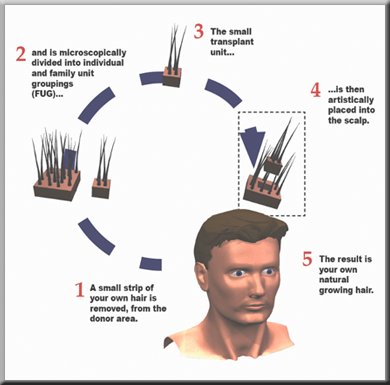Hair Transplantation
Hair transplantation is Inoculating hair follicle from the back part of your head to the bald part. It is this non-miniaturized hair on the back and sides that is surgically moved to the top of the head in the form of a strip of a skin. Because the hair on the permanent horseshoe is genetically programmed to grow a lifetime, it will continue to grow even though it's been transplanted to a different site. This has been repeatedly proven for more than thirty five years.
For some patients, a hairline may need recreation; for others, more extensive hair replacement maybe required. A few patients may want to correct sparse eyebrows, moustache or a scar on the scalp. All these individuals, both men and women, are good candidates for the procedure.

Other areas where Hair transplant can be used beside scalp:
Moustache
Eyebrows
Eyelashes
Hair loss v/s Hair Fall
Hair loss and hair fall are two separate things. Hair fall is a natural daily occurrence. Human head contains over 100,000 hair strands and one normally sheds 100 to 150 hair strands a day, every hair is genetically programmed. In general 85% of the hair on your head grow approximately 1 centimetre per month for about 2 to 6 years and then fall off.
Male Pattern Baldness (MPB)
Hair loss is primarily caused by a combination of ageing, a change in hormones and a family history (genetic) of baldness. As a rule, the earlier hair loss begins, the more severe the baldness will become. However, hair on back of your head are genetically programmed and scheduled to last long. Approximately, 30 percent Indian men will show signs of male pattern baldness by the age of 20. The incidence of male pattern baldness increases 10 percent per decade through a man's life.
Female Pattern Hair Loss
The most common type of hair loss seen in women is androgenic alopecia, also known as female pattern alopecia or baldness. Normal hair fall is approximately 100-120 hair strands per day. Fortunately, these hair strands are replaced. True hair strand loss occurs when lost hair strands are not re-grown or when the daily hair shed exceeds 125 hair strands. Genetically, hair loss can come from either parent's side of the family. The causes of female loss range often from iron deficiency to thyroid abnormalities to childbirth.
For both sexes, hair loss causes diminished self-esteem, stress, anxiety, depression and feelings of social inadequacy.
Preparing for your Surgery
Anaesthesia: Local Anaesthesia.
Incision
Skin is incised in the area between two ears on the back side.

The donor hair grafts are harvested from a strip of skin taken from area between two ears. The strip is Slivered in to smaller pieces. From these pieces follicular units are extracted, each containing one to three hair strands.
The recipient area is infiltrated after closure of donor area primarily. The harvested follicular units are inserted after making holes at the marked areas. The number of grafts harvested depends upon the requirement. Grafts up to 2000 - 2500 follicular units have been harvested in a single sitting.
Recovery and Results
Patient can resume light work from third day onwards. Sutures on back of head are removed after 7 days. However patient should not do any exercise for three weeks or shun any activity which will increase pressure in transplanted area. Mild swelling on forehead is possible which disappears after day or two. You can have head bath 4th day onwards. Crusts, scabs and effluvium fall off in next 4 weeks. No special care, medicines or frequent visits to doctor are required.
The donor site in the back of the head is not visible. Three to four months later, the transplanted hair begins to grow and continues to grow a half inch per month for the rest of your life .Hair strands will fall out of the newly transplanted follicles within two to six weeks after the procedure - this is normal!
Duration of Surgery: 5hrs- 6hrs.
Hospital Stay: Day Care Procedure.
Book an Appointment
Online Appointment Booking
 Whatsapp
Whatsapp
8885084495
REQUEST CALL BACK
Please send your details to get a call back from experts

